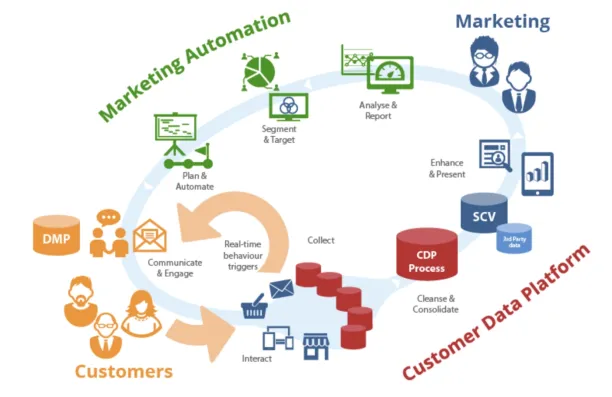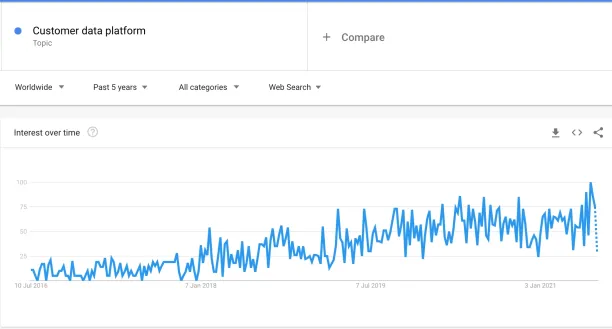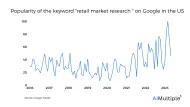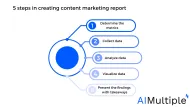Customer Data Platform (CDP): Applications & Benefits in 2024
CDP is a collection of software and platforms to build a company-wide unified customer database. Customer data platforms use data from various sources to create accurate and efficient customer profiles by transforming that data into standardized forms. CDP is an important and valuable component of marketing technology (martech), especially for marketing automation.
What is a Customer Data Platform (CDP)?
A CDP can collect, store, unify and analyze customer data from multiple sources and it is used to identify data-driven insights for marketing and sales strategy. Data collected by CDP includes:
- activities on an app or a website
- transactional data such as purchases, returns
- user reactions to campaigns and offers
- records from chatbots or call centre, etc.
- other data on users e.g. demographics
Data collected is converted by ETL (extract, transform, load) procedures such as merging, transforming and aggregating. CDPs have the ability to generate accessible data for third parties.
The image shows the workflow and processes for CDP systems between marketing activities and other tools below.

What is the level of interest in CDP?
CDP has became popular after 2010 the rise of customer relationship management (CRM) software and data management platforms (DMPs). Marketers have recognized CDPs as an alternative for other data management systems due to its benefits and capabilities. The interest in customer data platforms is seen below:

What are applications of CDP?
CDP software supports business to execute marketing activities by using data-driven insights about their customer profiles. These profiles are valuable, persistent, unified and created from multiple sources. CDPs can deliver a unified and single customer view into into a single platform by collecting first-party data of the company.
CDPs are a part of IT architecture for many companies. These platforms are used to improve marketing, sales and customer relationship management. The marketing practices which use CDPs include customer segmentation, profiling, communication management and analytics with predictive recommendations for customer retention.
Furthermore, the CDP Institute classifies CDPs by using the functions which CDP provides, such as data CDP, analytics CDP, campaign CDP and delivery CDP.
What are the benefits of CDP?
CDPs have significant benefits for businesses and marketers including :
Customer Data
- Providing accessible and well-maintained customer data
- Combining customer profiles by connecting characteristic features
- Creating a single database for customer profiles and a single and coherent view of the customer on an individual level
- Capabilities to integrate and share information with other marketing and sales systems
Analytics
- Nurturing and improving predictive analytics
Customer communication
- Optimization of timing and targeting of customer communication. CDPs enable companies to provide tailored communications and a consistent customer experience.
Data Protection
- Helping to improve compliance with data privacy regulations. Companies can manage to give access easily to the consumers by using centralised databases of CDPs.
What does the future hold for CDPs?
Although CDPs have good capabilities, there are some limitations about their analytical capabilities. The next stage may/will be the customer intelligence platform (CIP).
CIP is a platform which includes collection and analysis processes of all customer data. CIP tools can provide actionable customer insights and personalized data at a granular level. CIP can work with second-party and third-party data as well as first-party data by using machine learning models.
What are the challenges of CDP?
Technical
- Difficulties may occur during data integration process between different systems
- There are performance concerns about response time of CDPs. CDP’s speed to return real time data is an an important challenge for marketers and this is a challenge since CDPs collect data from numerous sources.
Data Protection
- When data protections regulations change according to the countries, it is not easy to adapt new rules effectively and quickly if you have an extensive and diversified CDP.
- Data security is critical for CDPs since they store customer data.
Financial
- It is hard to show financial benefits and effects on ROI of CDPs.
Differences between CDP and Data Management Platform (DMP)
CDP is a new technology compared to DMP and it collects data which is related to an identifiable individual and provide more personalized content. CDPs have abilities to store granular first-party data and it gives advantages to businesses for other marketing activities. Also, CDP can build customer profiles by using interactions from anonymous customers. CDPs can store customer data for long time, because CDPs use users data and they can keep users’ data until they take a request to delete users data.
DMP collects anonymous second-party and third-party data which contains useful information for advertising activities. This means DMPs are more effective for anonymous and new customers. DMPs usually keep customer data for short time (e.g. 90 days), because DMPs are created for advertising platforms. Data grows old fast and its value deteriorates therefore long term storage may not be criticial for advertising purposes.
However, although there are differences between DMP and CDP, the two can be used together. For example, first, customer data is sent to a DMP system and then a CDP is used to provide personalization.
Next steps
For more, feel free to read our article about first-party data:
If you need help in identifying CDP solutions for your business, we can help you get started:
This article was drafted by former AIMultiple industry analyst Ayşegül Takımoğlu.

Cem has been the principal analyst at AIMultiple since 2017. AIMultiple informs hundreds of thousands of businesses (as per similarWeb) including 60% of Fortune 500 every month.
Cem's work has been cited by leading global publications including Business Insider, Forbes, Washington Post, global firms like Deloitte, HPE, NGOs like World Economic Forum and supranational organizations like European Commission. You can see more reputable companies and media that referenced AIMultiple.
Throughout his career, Cem served as a tech consultant, tech buyer and tech entrepreneur. He advised businesses on their enterprise software, automation, cloud, AI / ML and other technology related decisions at McKinsey & Company and Altman Solon for more than a decade. He also published a McKinsey report on digitalization.
He led technology strategy and procurement of a telco while reporting to the CEO. He has also led commercial growth of deep tech company Hypatos that reached a 7 digit annual recurring revenue and a 9 digit valuation from 0 within 2 years. Cem's work in Hypatos was covered by leading technology publications like TechCrunch and Business Insider.
Cem regularly speaks at international technology conferences. He graduated from Bogazici University as a computer engineer and holds an MBA from Columbia Business School.
To stay up-to-date on B2B tech & accelerate your enterprise:
Follow on

Comments
Your email address will not be published. All fields are required.